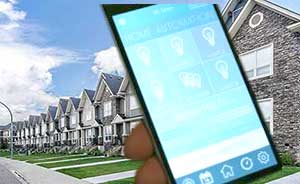More and more homeowners are turning  on to what is called “Smart Home” technology. These are a variety of electronic devices that are controlled remotely from within the home or via a smartphone or the Internet to provide added security, comfort, energy efficiency, and “green initiative” conservation.
on to what is called “Smart Home” technology. These are a variety of electronic devices that are controlled remotely from within the home or via a smartphone or the Internet to provide added security, comfort, energy efficiency, and “green initiative” conservation.
Some of the most common technologies control heating and air conditioning, appliances, lighting, smoke and carbon monoxide detectors, and security systems. They are also capable of interacting with each other and detecting if something is amiss. Taking it to the next level, some technology, such as that for your HVAC system, will even learn your patterns and create schedules for heating and cooling according to your normal usage.
Some of the more popular brand names for smart home devices include Nest and Ring. And you might recognize the voice-controlled devices such as Amazon’s Alexa, Google Assistant/Home and Apple’s Siri which can control your smart home technology, as well as your smartphone or Apple watch.
If you’re new to smart home technology, the first place to start is with a programmable thermostat. This can save hundreds of dollars each year in heating and cooling costs by monitoring and schedule usage. Next, you may want to invest in a combination smoke and carbon monoxide detector.
Another recommended technology is a wet switch. These are attached to water-using devices such as your washing machine, refrigerator or attic-located heat pump. If the device detects a water leak, it automatically shuts off the water supply and notifies the homeowner.
You don’t need to purchase a large amount of technology all at once. Devices can be added on as you like, either by the homeowners themselves or through a professional installer.
One of the best ways to coordinate smart home technology is through a subscription-based service such as Alarm.com. As you add devices to your home, you simply add them on to your service, and you pay only for the items you have installed. This creates a centralized platform and a one-stop resource for managing your entire smart home. An easy-to-use platform, Alarm.com allows end users to customize their settings, and view tutorials on how to install and use their technology to its best advantage.
Other Smart Home Devices
Just about every area of your home can be controlled or monitored by a smart home device. Consider security sensors, motion detectors, fire detectors, smart locks with keypads or fingerprint access, garage door controls, hi-def video monitoring and night-vision cameras, and doorbell cameras with two-way audio, just to name a few. Lighting can be controlled through smart and dimmer switches, appliances can be turned on or off, and audio systems can be programmed. Smart technology also adds a green element to any home by offering energy efficiency.
With smart home technology, you never have to worry that you’ve left the oven lit or the lights on. You can check in to your system from any remote device to turn them off or on remotely, and receive notifications and alarms if problems occur within your household systems. You can even lock or unlock the front door from the convenience of your smart phone.
Increase Your Home’s Value with Smart Technology
A 2017 home survey by HomeAdvisor reported that 77% of millennials have already purchased a smart home product, and that number is on the rise. In addition to the convenience and security these devices offer, they can also increase a home’s value, upping its selling price by up to 5%.
Contact Först Consulting Group
If you have questions about smart home technology and are located in the Northern Virginia or Washington DC area, Först Consulting Group would be glad to consult with you. We can advise you on the best technology solutions for your home’s safety, comfort and energy efficiency whether you are looking into new construction or retrofitting these devices into your existing home. Please contact us today to set your appointment.




